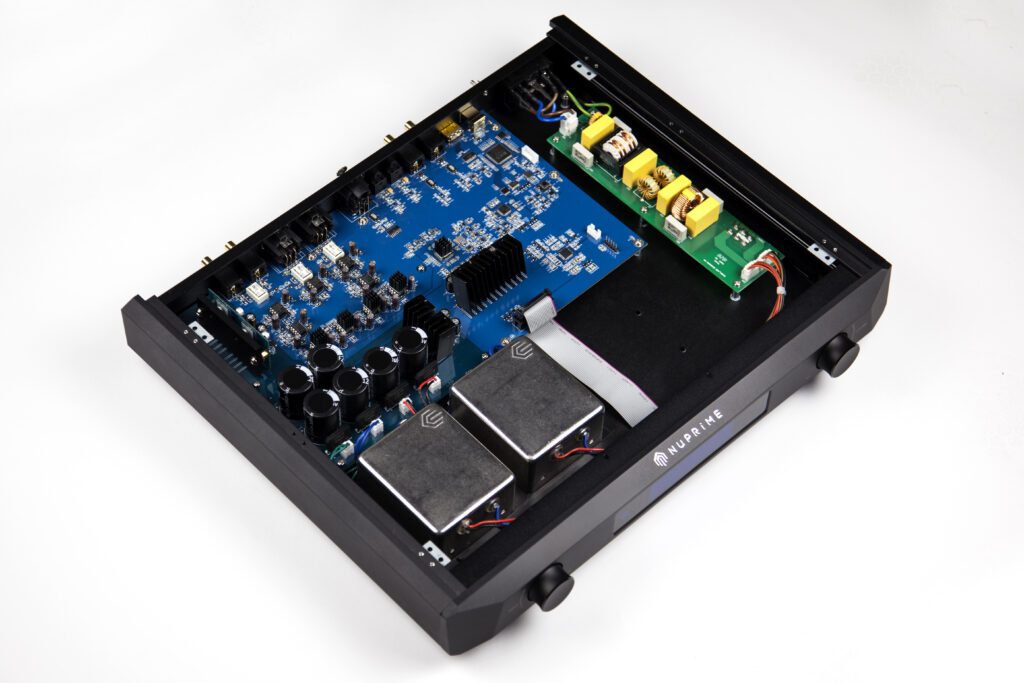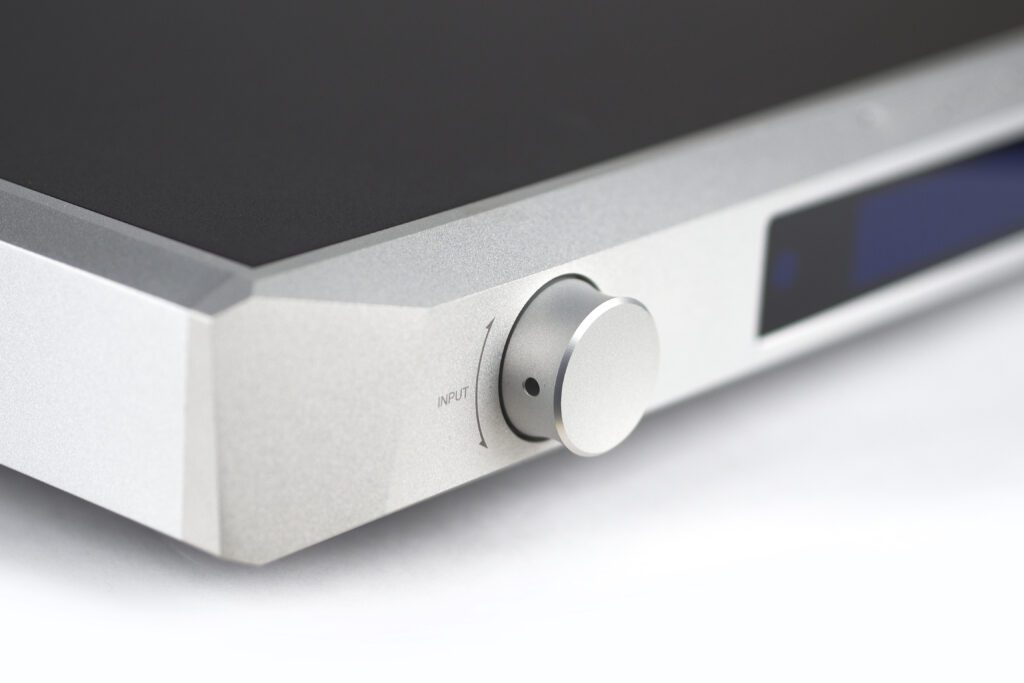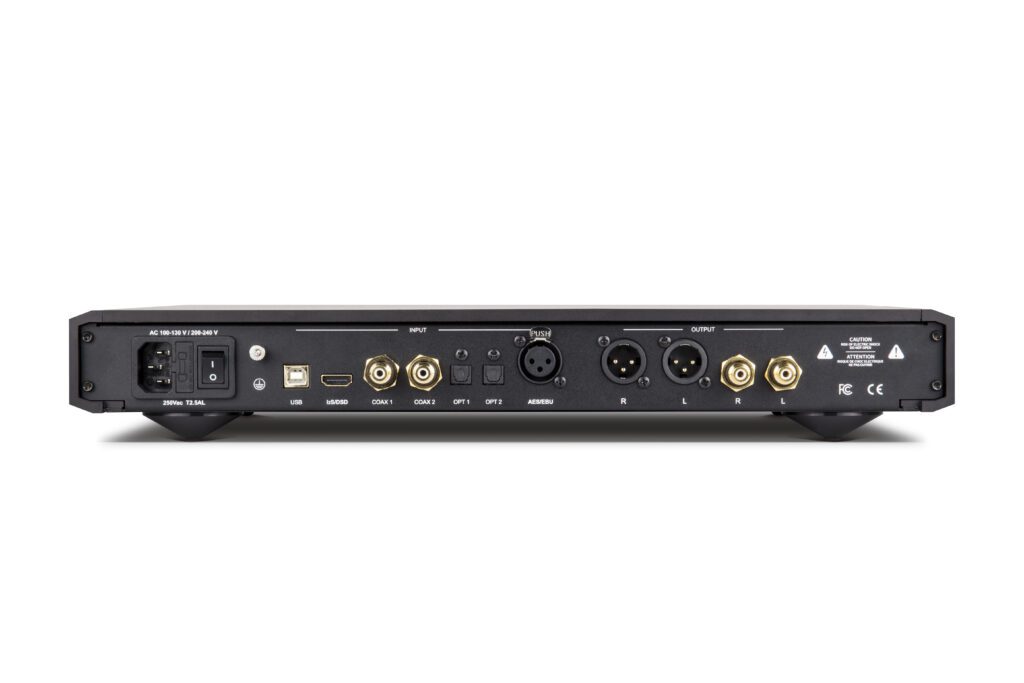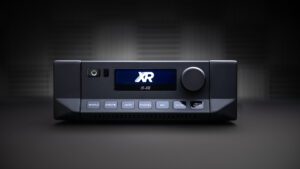
Spoiled! That’s how many audio reviewers get, me included. Only last month I was putting the finishing touches on two DAC reviews of products costing in the mid £20,000s, so it could be so very easy to take an “I don’t get out of bed for less than £10,000” approach to digital audio. But if you do go down that rabbit hole, you’ll miss the NuPrime Evolution DAC, which is the kind of product that punches so far above its weight, it could give those more expensive DACs a damn good thrashing. Or at the very least, stand its ground.
The Evolution DAC is a slim, elegant, extremely well-built DAC, with a tasteful laser-cut logo cut into the top of the chamfered edge of its thick aluminium top-plate. The controls are on the face of things simple, with one knob selecting the input as standard, the other adjusts volume if not set to full output. These also control power and mute functions and select and navigate the menu options. These options are replicated on a solid remote handset, but this has individual buttons for each function. The handset is large enough that it isn’t festooned with tiny, unintelligible functions, and yet fits well in the hand. It’s also beefy enough for hand-to-hand combat should the need arise… if someone is hogging the music server, for example.
Day-to-day
The menu and day-to-day functionality are navigated by means of the central panel, which combines a two-deck simple text display and a remote eye behind blue glass. In regular use, the top line displays input and output level, the bottom displays format and sample rate: while in menu mode the top line shows what you are adjusting, and the bottom line shows status.

We’re so used to multi-use digital devices today, it’s nice to see a DAC that is just a DAC sometimes. The rear panel is a giveaway; the Evolution has a Type 2 USB, two coaxial and two optical S/PDIF inputs, an AES/EBU balanced input a HDMI socket for I2S-based sources. This last one is designed for NuPrime’s own digital front ends, and users of other I2S-supporting sources (PS Audio, Rockna) will need to check whether their HDMI pinning matches that of the NuPrime. Fortunately, it’s clearly marked in the manual, which is available online. As ever, high-resolution USB is available off the shelf for Mac users, while Windows 10 users must download a driver from NuPrime’s own site. Anyone using a Windows computer with an earlier version of the operating system misses out as they are unsupported. If you are still using a Windows 8 PC, there’s almost a decade of wonders to show you!
Although it’s nice to have a DAC that doesn’t have a streamer or a headphone amp thrown in, that’s not to say the DAC is inflexible. The single-ended and balanced outputs of the DAC can be used in fixed output mode, or they can be used in variable output, making the Evolution DAC a preamplifier in its own right. I would argue that to get the best from the DAC it should be used with a separate, high-quality line stage preamplifier, but using it as a DAC-meets-preamp hub is very acceptable sounding. The key to that being a fine preamplifier is it acts in the analogue domain, running from a high-performance power supply, instead of bit truncation. While ‘bit-chopping’ is now well out of its infancy and can sound good, at the present it’s often bettered by a good analogue line stage.
Taking the job seriously
The way NuPrime handles its power feeds shows just how advanced the company is, and how seriously it takes its job. The power inlet is immediately filtered to reduce high-frequency and radio-frequency interference from the mains itself. That cleaned up power is then fed into two separate C-core transformers; one for the digital domain, the other for the analogue stages, with each being designed in part to meet the demands and requirements of that section and to maintain a degree of aloofness and isolation that would normally require multiple boxes. Make that ‘meet and comfortably exceed…’ because with a bank with nigh on 70,000µF of reservoir capacitance in the preamplifier stage, it has greater power reserves than many integrated amplifiers.
NuPrime’s beating heart is a popular choice among high-end digital brands; the 32bit ES9038PRO Sabre DAC. This is one of the highest performing ‘off the shelf’ converters currently available, but NuPrime links it to the company’s own PSRC IC chip that provids sample rate conversion (both up and down) from PCM and DSD sources. You can upconvert 44.1kHz PCM to 768kHz and DSD64 to DSD512 and can convert between PCM and DSD at your leisure. The NuPrime also supports MQA and MQA Studio files.
Drilling down into the menu system allows a wide range of adjustments, including channel and phase inversion, three output level and two brightness levels and the choice of seven different digital filter shapes (fast and slow minimum phase, fast and slow linear phase, fast apodizing, a fast hybrid filter and the standard brickwall option). I’m normally a ‘set and forget’ guy when it comes to filters, but in this case, I found the difference between formats made a big difference… I preferred the hybrid setting for lower-quality online streams and fast minimum phase for the rest. You may find a different result, but the options are easy to access. The only things missing from the menus are the ability to name inputs and possibly greater granularity in the output and brightness levels, but these last are probably splitting hairs.
Audition demanding
This is a DAC that demands audition, but demands that audition after a week or more of burning in. Listen to it cold and it sounds pretty good, but there is some dramatic transformation that happens sometime at the end of week one and the start of week two that turnes it from something good into something wonderful. During that conditioning process, things tend to oscillate between good and bad, which makes me think this might be down to that reservoir capacitance in the analogue section taking its merry time to saturate. In this respect it’s a little like a classic Naim Audio amplifier; like a Naim amp what you end up with bears little sonic resemblance to what you get mid-way through that breaking in process, and like a Naim amp it means the NuPrime is probably best left constantly powered and in standby.

There are times when as a reviewer you get a spot of ‘ennui’; having to use ‘music’ in your day job can make you less likely to play music during ‘downtime’. What resets that is something good sounding, easy to use, good sounding, not terminally expensive, good sounding, sensible, good sounding, and good sounding. It also must sound good. Well, guess what? The Evolution DAC sounds damn fantastic!
I’ve been using the NuPrime Evolution DAC as my prime converter for some weeks now. That’s ‘prime’ in two senses; both the device under test and comparison, and the thing that primes my listening, both critically and for enjoyment. In each case, it’s the degree of transparency that shines through. There’s not simply an honesty to the sound; there’s a near-total absence of ‘sound’ imposed on the music by this converter. Where this scores so highly is that it has the same ‘let the music through unsullied’ response to the humblest file formats as it does the best. OK, so the Evolution DAC will lay bare the worst examples of sample and signal compression, but what’s surprising is just how many times I played such music and found it didn’t matter… unless it was Oasis, when compression was just a good excuse not to like Oasis.
Clearly transparent
As I moved around my music, it became, er, clear this transparency applied universally; soundstaging, inner detail, soliditiy, vocal articulation, dynamics… everything. Music always sounds fliud and never boring, even on recordings I thought a bit ‘meh!’ New albums like Ludovico Einaudi’s Underwater [Decca] sound like old friends, while those that are old friends [Ed Bickert’s Out of the Past on Sackville] are heard and enjoyed anew, without any of the digital ‘baggage’ than normally comes with those recordings.

The NuPrime Evolution DAC came as a surprise to me, it costs less than the power cord a top-class DAC might use but goes toe-to-toe with the best of them. If you aren’t obsessed by superannuated electronics wizards that have been making audio devices since the fall of the Roman empire or fixated on having a price tag that wouldn’t look out of place on a private jet, the NuPrime Evolution DAC is the one to beat.
TECHNICAL SPECIFICATIONS
- Type: DAC/digital preamplifier
- Inputs: USB, HDMI (for I2S), coaxial RCA (x2), Toslink (x2), AES/EBU
- Outputs: RCA stereo pair (single-ended), XLR stereo pair (balanced), fixed or variable output
- Frequency response: 20 Hz–20 KHz / ±0.3 dB. SNR: >110 dB
- THD+N: < 0.0003%
- Dimensions (W×H×D): 43 × 5.5 × 31.5cm
- Weight: 5.2Kg
- Price: £2,950
Manufacturer:
NuPrime
URL: nuprimeaudio.com
UK Distributor:
ADMM (Audiophile Digital Music Masters Ltd)
Tel: +44(0)1252 784525
By Alan Sircom
More articles from this authorRead Next From Review
See all
PrimaLuna EVO 100 phono preamplifier
- Apr 22, 2024

Reiki Audio SuperSwitch Master Pro + Servant Pro
- Mar 27, 2024

Melco Audio N1-S38 music server
- Mar 27, 2024











